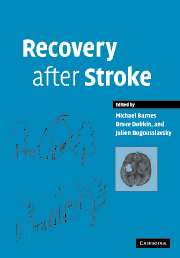Book contents
- Frontmatter
- Contents
- List of authors
- Preface
- 1 Stroke: background, epidemiology, etiology and avoiding recurrence
- 2 Principles of recovery after stroke
- 3 Regenerative ability in the central nervous system
- 4 Cerebral reorganization after sensorimotor stroke
- 5 Some personal lessons from imaging brain in recovery from stroke
- 6 Measurement in stroke: activity and quality of life
- 7 The impact of rehabilitation on stroke outcomes: what is the evidence?
- 8 Is early neurorehabilitation useful?
- 9 Community rehabilitation after stroke: is there no place like home?
- 10 Physical therapy
- 11 Abnormal movements after stroke
- 12 Spasticity and pain after stroke
- 13 Balance disorders and vertigo after stroke: assessment and rehabilitation
- 14 Management of dysphagia after stroke
- 15 Continence and stroke
- 16 Sex and relationships following stroke
- 17 Rehabilitation of visual disorders after stroke
- 18 Aphasia and dysarthria after stroke
- 19 Cognitive recovery after stroke
- 20 Stroke-related dementia
- 21 Depression and fatigue after stroke
- 22 Sleep disorders after stroke
- 23 Technology for recovery after stroke
- 24 Vocational rehabilitation
- 25 A patient's perspective
- Index
5 - Some personal lessons from imaging brain in recovery from stroke
Published online by Cambridge University Press: 05 August 2016
- Frontmatter
- Contents
- List of authors
- Preface
- 1 Stroke: background, epidemiology, etiology and avoiding recurrence
- 2 Principles of recovery after stroke
- 3 Regenerative ability in the central nervous system
- 4 Cerebral reorganization after sensorimotor stroke
- 5 Some personal lessons from imaging brain in recovery from stroke
- 6 Measurement in stroke: activity and quality of life
- 7 The impact of rehabilitation on stroke outcomes: what is the evidence?
- 8 Is early neurorehabilitation useful?
- 9 Community rehabilitation after stroke: is there no place like home?
- 10 Physical therapy
- 11 Abnormal movements after stroke
- 12 Spasticity and pain after stroke
- 13 Balance disorders and vertigo after stroke: assessment and rehabilitation
- 14 Management of dysphagia after stroke
- 15 Continence and stroke
- 16 Sex and relationships following stroke
- 17 Rehabilitation of visual disorders after stroke
- 18 Aphasia and dysarthria after stroke
- 19 Cognitive recovery after stroke
- 20 Stroke-related dementia
- 21 Depression and fatigue after stroke
- 22 Sleep disorders after stroke
- 23 Technology for recovery after stroke
- 24 Vocational rehabilitation
- 25 A patient's perspective
- Index
Summary
Introduction
With imaging studies of recovery from stroke, it became clear that the brain retains a plastic potential in its motor and language domains not only in young rats or monkeys but also in adult humans and even in old and lesioned brains (Chollet et al., 1991; Weiller et al., 1992; 1995). This “reorganization” is individually highly variable (Weiller et al., 1993a), relates to recovery of lost function (Liepert et al., 1998), and can be influenced by drugs, training, and rehabilitation (Musso et al., 1999; Liepert et al., 2000a; Pariente et al., 2001). In our opinion, there is not just one single crucial component of recovery. Rather, recovery of function seems to imply the “reconnection” or perhaps better the “recoordination” of a network of areas, each of which may be specialized in one or more aspect of the lost function but requires the coherent and timely support from others to reach a high level of proficiency (Weiller and Rijntjes, 1999). Moreover, we can learn about how the normal brain works when looking at the diseased brain.
Brain anatomy of recovery from stroke
“Plastic” changes represent a uniform reaction pattern of the brain and occur under very different conditions in the intact as well as in the lesioned brain (Merzenich et al., 1982; Kaas, 1991) as a result of learning or adaptation, with or without any concomitant change in behavioral performance (Rijntjes et al., 1997). After lesions, plastic changes can either be a consequence of the structural defect (e.g. diaschisis) or a result of active intervention (e.g. rehabilitational procedures) (Weiller, 1998) In animal experiments, plastic changes have been demonstrated after recovery of lost motor function, including peri-lesional extensions of representations, shifts from primary to secondary parallel processing systems, and recruitment of homologous areas of the unaffected hemisphere (Fries et al., 1993; Nudo, 1997; Rouiller et al., 1998; Darian-Smith et al., 1999; Liu andRouiller, 1999). Such changes have also been identified in human stroke victims (Chollet et al., 1991; DiPiero et al., 1992; Weiller et al., 1992, 1993a; Seitz et al., 1994, 1998; Weder and Seitz, 1994; Binkofski et al., 1996; Dettmers et al., 1997).
In most studies using functional magnetic resonance imaging (FMRI) or positron emission tomography (PET), a widespread network of neurons was activated in both hemispheres after recovery.
- Type
- Chapter
- Information
- Recovery after Stroke , pp. 124 - 134Publisher: Cambridge University PressPrint publication year: 2005

